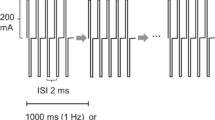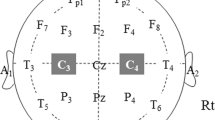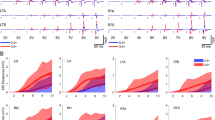Abstract
To study if spinal motor evoked potentials (SpMEPs), muscle responses after electrical stimulation of the spinal cord, can monitor the corticospinal tract. Study 1 comprised 10 consecutive cervical or thoracic myelopathic patients. We recorded three types of muscle responses intraoperatively: (1) transcranial motor evoked potentials (TcMEPs), (2) SpMEPs and (3) SpMEPs + TcMEPs from the abductor hallucis (AH) using train stimulation. Study 2 dealt with 5 patients, who underwent paired train stimulation to the spinal cord with intertrain interval of 50–60 ms for recording AH SpMEPs. We will also describe two illustrative cases to demonstrate the clinical value of AH SpMEPs for monitoring the motor pathway. In Study 1, SpMEPs and SpMEPs + TcMEPs recorded from AH measured nearly the same, suggesting the collision of the cranially evoked volleys with the antidromic signals induced by spinal cord stimulation via the corticospinal tracts. In Study 2, the first and second train stimuli elicited almost identical SpMEPs, indicating a quick return of transmission after 50–60 ms considered characteristic of the corticospinal tract rather than the dorsal column, which would have recovered much more slowly. Of the two patients presented, one had no post-operative neurological deteriorations as anticipated by stable SpMEPs, despite otherwise insufficient IONM, and the other developed post-operative motor deficits as predicted by simultaneous reduction of TcMEPs and SpMEPs in the face of normal SEPs. Electrical stimulation of the spinal cord primarily activates the corticospinal tract to mediate SpMEPs.













Similar content being viewed by others
References
Matsuyama Y, Sakai Y, Katayama Y, et al. Surgical results of intramedullary spinal cord tumor with spinal cord monitoring to guide extent of resection. J Neurosurg Spine. 2009;10:404–13.
Matsumoto M, Toyama Y, Chikuda H, et al. Outcomes of fusion surgery for ossification of the posterior longitudinal ligament of the thoracic spine: a multicenter retrospective survey: clinical article. J Neurosurg Spine. 2011;15:380–5.
Smith JS, Klineberg E, Lafage V, et al. Prospective multicenter assessment of perioperative and minimum 2-year postoperative complication rates associated with adult spinal deformity surgery. J Neurosurg Spine. 2016;25:1–14.
Nash CL, Brodkey JS, Croft TJ. A model for electrical monitoring of spinal cord function in scoliosis patients undergoing correction (abstract). J Bone Joint Surg Am. 1972;54:197–8.
Deletis V, Sala F. Intraoperative neurophysiological monitoring of the spinal cord during spinal cord and spine surgery: a review focus on the corticospinal tracts. Clin Neurophysiol. 2008;119:248–64.
Iwasaki H, Tamaki T, Yoshida M, et al. Efficacy and limitations of current methods of intraoperative spinal cord monitoring. J Orthop Sci. 2003;8:635–42.
Lyon R, Feiner J, Lieberman JA. Progressive suppression of motor evoked potentials during general anesthesia: the phenomenon of “anesthetic fade.” J Neurosurg Anesthesiol. 2005;17:13–9.
MacDonald DB, Skinner S, Shils J, et al. Intraoperative motor evoked potential monitoring—a position statement by the American Society of Neuro-physiological Monitoring. Clin Neurophysiol. 2013;124:2291–316.
Ushirozako H, Yoshida G, Kobayashi S, et al. Impact of total propofol dose during spinal surgery: anesthetic fade on transcranial motor evoked potentials. J Neurosurg Spine. 2019;30:705–13.
Machida M, Weinstein SL, Yamada T, et al. Spinal cord monitoring. Electrophysiological measures of sensory and motor function during spinal surgery. Spine. 1985;10:407–13.
Taylor BA, Fennelly ME, Taylor A, et al. Temporal summation-the key to motor evoked potential spinal cord monitoring in humans. J Neurol Neurosurg Psychiatry. 1993;56:104–6.
Mochida K, Shinomiya K, Komori H, et al. A new method of multisegment motor pathway monitoring using muscle potentials after train spinal stimulation. Spine. 1995;20:2240–6.
Nishiura H. Spinal motor tract monitoring utilizing evoked action potentials elicited by train stimulation on spinal cord. J Wakayama Med Soc. 1999;50:179–87 (in Japanese).
Tamaki T, Ando M, Nakagawa Y, et al. Intraoperative spinal cord monitoring addressed for spine and spinal cord surgeon: focusing on the basic knowledge as a team-member of surgical treatment with spinal cord monitoring. Spine Surg Relat Res. 2021;5:120–32.
Deletis V, Kothbauer KF, Sala F, et al. Letter to the editor: electrical activity in limb muscles after spinal cord stimulation is not specific for the corticospinal tract. J Neurosurg Spine. 2017;26:267–9.
Deletis V, Seidel K, Sala F, et al. Intraoperative identification of the corticospinal tract and dorsal column of the spinal cord by electrical stimulation. J Neurol Neurosurg Psychiatry. 2018;89:754–61.
Kobayashi K, Ando K, Tsushima M, et al. Characteristics of multi-channel Br(E)-MsEP waveforms for the lower extremity muscles in thoracic spine surgery: comparison based on preoperative motor status. Eur Spine J. 2019;28:484–91.
Shils JL, Arle JE. Intraoperative neurophysiologic methods for spinal cord stimulator placement under general anesthesia. Neuromodulation. 2012;15:560–71.
Matsuda H, Shimazu A. Intraoperative spinal cord monitoring using electric responses to stimulation of caudal spinal cord or motor cortex. In: Desmedt JE, editor. Neuromonitoring in surgery. Amsterdam: Elsevier; 1989.
Yamazaki M, Mochizuki M, Ikeda Y, et al. Clinical results of surgery for thoracic myelopathy caused by ossification of the posterior longitudinal ligament: operative indication of posterior decompression with instrumented fusion. Spine. 2006;31:1452–60.
Tamaki T, Yamashita T, Kobayashi H, et al. Spinal cord evoked potential after stimulation to the spinal cord (SCEP), spinal cord monitoring—basic data obtained from animal experimental studies. Jpn J Electroencephalogr Electromyogr. 1972;1:196 (in Japanese).
Ando M, Tamaki T, Yoshida M, et al. Intraoperative spinal cord monitoring using combined motor and sensory evoked potentials recorded from the spinal cord during surgery for intramedullary spinal cord tumor. Clin Neurol Neurosurg. 2015;133:18–23.
Su CF, Haghighi SS, Oro JJ, et al. “Backfiring” in spinal cord monitoring: high thoracic spinal cord stimulation evokes sciatic response by antidromic sensory pathway conduction, not motor tract conduction. Spine. 1992;17:504–8.
Poncelet L, Michaux C, Balligand M. Motor evoked potentials induced by electrical stimulation of the spine in dogs: which structures are involved? Electroenceph Clin Neurophysiol. 1995;97:179–83.
Toleikis JR, Skelly JP, Carlvin AO, et al. Spinally elicited peripheral nerve responses are sensory rather than motor. Clin Neurophysiol. 2000;111:736–42.
Deletis V. The ‘motor’ inaccuracy in neurogenic motor evoked potentials. Clin Neurophysiol. 2001;112:1365–6.
Minahan RE, Sepkuty JP, Lesser RP, et al. Anterior spinal cord injury with preserved neurogenic `motor’ evoked potentials. Clin Neurophysiol. 2001;112:1442–50.
Shinomiya K, Furuya K, Kamikozuru M, et al. Monitoring of the spinal cord function using evoked spinal cord potentials. Nihonseikeigekazasshi. 1982;56:1551–60.
Soeda S, Satomi K, Hirabayashi K. Experimental studies on spinal cord function using evoked action potentials. Int Orthop. 1990;14:151–3.
Costa P, Deletis V. Cortical activity after stimulation of the corticospinal tract in the spinal cord. Clin Neurophysiol. 2016;127:1726–33.
Péréon Y, Tich SNT, Delécrin J, et al. Combined spinal cord monitoring using neurogenic mixed evoked potentials and collision techniques. Spine. 2002;27:1571–6.
Haghighi SS, York DH, Gaines RW, et al. Monitoring of motor tracts with spinal cord stimulation. Spine. 1994;19:1518–24.
Tamaki T, Kubota S. History of the development of intraoperative spinal cord monitoring. Eur Spine J. 2007;16:140–6.
Wilson-Holden TJ, Padberg AM, Parkinson JD, et al. A prospective comparison of neurogenic mixed evoked potential stimulation methods: utility of epidural elicitation during posterior spinal surgery. Spine. 2000;25:2364–71.
Funding
None.
Author information
Authors and Affiliations
Contributions
MA and TT designed the study. MA, KM and HI performed surgeries and collected data. HY and HIwasa analyzed the data statistically. MA wrote the article with editing from co-authors. TT, TT, TS and JK supervised the study. All authors approved the final article.
Corresponding author
Ethics declarations
Conflict of interest
None of the authors have potential conflicts of interest to be disclosed.
Ethical approval
All procedures performed in studies involving human participants were in accordance with the ethical standards of the institutional committee (Wakayama Rosai Hospital ethics committee, number 15–26) and with the 1964 Helsinki declaration and its later amendments or comparable ethical standards.
Informed consent
Informed consent was obtained from all individual participants included in the study. Additional informed consent was obtained from all individual participants for whom identifying information is included in this article.
Additional information
Publisher's Note
Springer Nature remains neutral with regard to jurisdictional claims in published maps and institutional affiliations.
This study was performed at Wakayama Rosai Hospital.
Rights and permissions
About this article
Cite this article
Ando, M., Tamaki, T., Maio, K. et al. The muscle evoked potential after epidural electrical stimulation of the spinal cord as a monitor for the corticospinal tract: studies by collision technique and double train stimulation. J Clin Monit Comput 36, 1053–1067 (2022). https://doi.org/10.1007/s10877-021-00735-8
Received:
Accepted:
Published:
Issue Date:
DOI: https://doi.org/10.1007/s10877-021-00735-8




